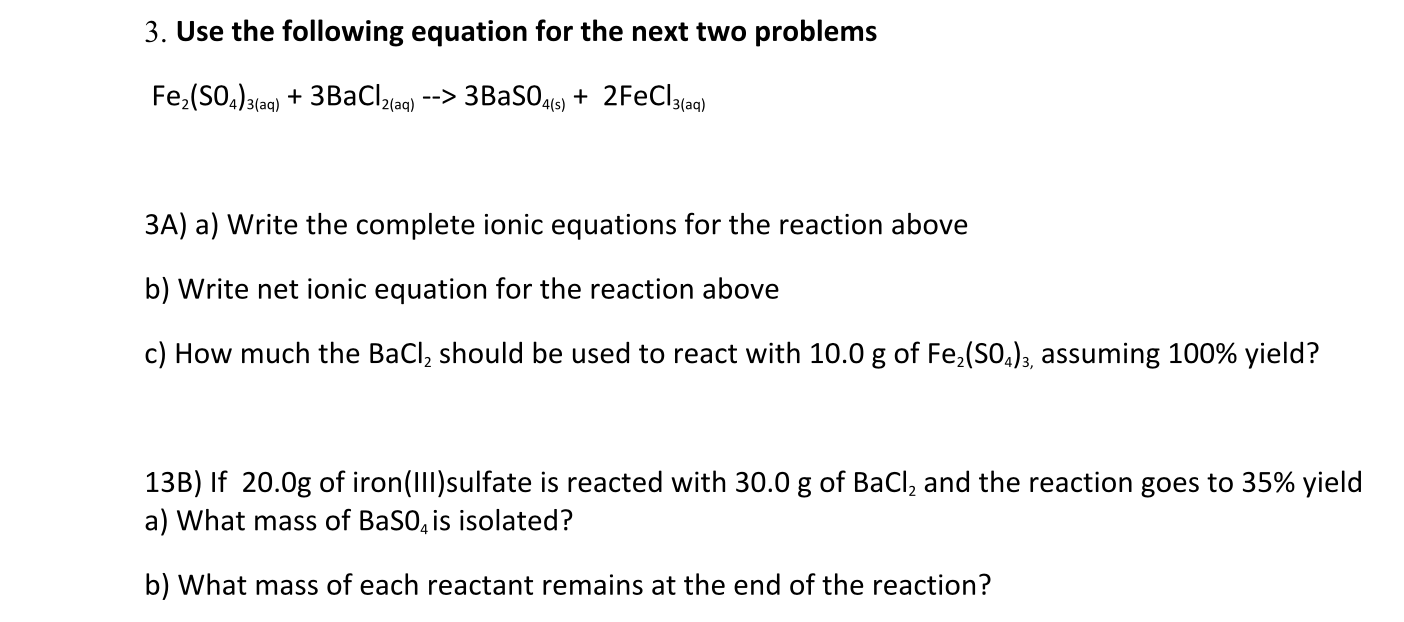3. Use the following equation for the next two problems Fe,(SO,)3(aq) + 3BaCl(aq) --> 3BASO,416) + 2FeCl3lag) 3A) a) Write the complete ionic equations for the reaction above b) Write net ionic equation for the reaction above c) How much the BaCl, should be used to react with 10.0 g of Fe,(SO.)3, assuming 100% yield? 13B) If 20.0g of iron(III)sulfate is reacted with 30.0 g of BaCl, and the reaction goes to 35% yield a) What mass of BaSO, is isolated? b) What mass of each reactant remains at the end of the reaction?
3. Use the following equation for the next two problems Fe,(SO,)3(aq) + 3BaCl(aq) --> 3BASO,416) + 2FeCl3lag) 3A) a) Write the complete ionic equations for the reaction above b) Write net ionic equation for the reaction above c) How much the BaCl, should be used to react with 10.0 g of Fe,(SO.)3, assuming 100% yield? 13B) If 20.0g of iron(III)sulfate is reacted with 30.0 g of BaCl, and the reaction goes to 35% yield a) What mass of BaSO, is isolated? b) What mass of each reactant remains at the end of the reaction?
Chemistry: An Atoms First Approach
2nd Edition
ISBN:9781305079243
Author:Steven S. Zumdahl, Susan A. Zumdahl
Publisher:Steven S. Zumdahl, Susan A. Zumdahl
Chapter6: Types Of Chemical Reactions And Solution Stoichiometry
Section: Chapter Questions
Problem 132CP: Consider reacting copper(II) sulfate with iron. Two possible reactions can occur, as represented by...
Related questions
Question
100%

Transcribed Image Text:3. Use the following equation for the next two problems
Fe,(SO,)3(aq) + 3BaCl(aq) --> 3BASO,416) + 2FeCl3lag)
3A) a) Write the complete ionic equations for the reaction above
b) Write net ionic equation for the reaction above
c) How much the BaCl, should be used to react with 10.0 g of Fe,(SO.)3, assuming 100% yield?
13B) If 20.0g of iron(III)sulfate is reacted with 30.0 g of BaCl, and the reaction goes to 35% yield
a) What mass of BaSO, is isolated?
b) What mass of each reactant remains at the end of the reaction?
Expert Solution
This question has been solved!
Explore an expertly crafted, step-by-step solution for a thorough understanding of key concepts.
This is a popular solution!
Trending now
This is a popular solution!
Step by step
Solved in 3 steps

Recommended textbooks for you

Chemistry: An Atoms First Approach
Chemistry
ISBN:
9781305079243
Author:
Steven S. Zumdahl, Susan A. Zumdahl
Publisher:
Cengage Learning

Chemistry
Chemistry
ISBN:
9781305957404
Author:
Steven S. Zumdahl, Susan A. Zumdahl, Donald J. DeCoste
Publisher:
Cengage Learning


Chemistry: An Atoms First Approach
Chemistry
ISBN:
9781305079243
Author:
Steven S. Zumdahl, Susan A. Zumdahl
Publisher:
Cengage Learning

Chemistry
Chemistry
ISBN:
9781305957404
Author:
Steven S. Zumdahl, Susan A. Zumdahl, Donald J. DeCoste
Publisher:
Cengage Learning


Chemistry for Engineering Students
Chemistry
ISBN:
9781337398909
Author:
Lawrence S. Brown, Tom Holme
Publisher:
Cengage Learning

Chemistry: Principles and Reactions
Chemistry
ISBN:
9781305079373
Author:
William L. Masterton, Cecile N. Hurley
Publisher:
Cengage Learning

Principles of Modern Chemistry
Chemistry
ISBN:
9781305079113
Author:
David W. Oxtoby, H. Pat Gillis, Laurie J. Butler
Publisher:
Cengage Learning